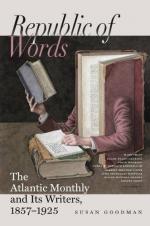Our kind friend kept bringing out one unexpected and wholly unexpectable thing after another, as if he were a magician, and had only to fling a private signal into the air, and some attendant imp would hand forth any strange relic we might choose to ask for. He was especially rich in drawings by the Old Masters, producing two or three, of exquisite delicacy, by Raphael, one by Salvator, a head by Rembrandt, and others, in chalk or pen-and-ink, by Giordano, Benvenuto Cellini, and hands almost as famous; and besides what were shown us, there seemed to be an endless supply of these art-treasures in reserve. On the wall hung a crayon-portrait of Sterne, never engraved, representing him as a rather young man, blooming, and not uncomely: it was the worldly face of a man fond of pleasure, but without that ugly, keen, sarcastic, odd expression that we see in his only engraved portrait. The picture is an original, and must needs be very valuable; and we wish it might be prefixed to some new and worthier biography of a writer whose character the world has always treated with singular harshness, considering how much it owes him. There was likewise a crayon-portrait of Sterne’s wife, looking so haughty and unamiable, that the wonder is, how he ever contrived to live a week with such an awful woman.
After looking at these, and a great many more things than I can remember, above stairs, we went down to a parlor, where this wonderful bookseller opened an old cabinet, containing numberless drawers, and looking just fit to be the repository of such knick-knacks as were stored up in it. He appeared to possess more treasures than he himself knew of, or knew where to find; but, rummaging here and there, he brought forth things new and old: rose-nobles, Victoria crowns, gold angels, double-sovereigns of George IV., two-guinea pieces of George II.; a marriage-medal of the first Napoleon, only forty-five of which were ever struck off, and of which even the British Museum does not contain a specimen like this, in gold; a brass medal, three or four inches in diameter, of a Roman Emperor; together with buckles, bracelets, amulets, and I know not what besides. There was a green silk tassel from the fringe of Queen Mary’s bed at Holyrood Palace. There were illuminated missals, antique Latin Bibles, and (what may seem of especial interest to the historian) a Secret-Book of Queen Elizabeth, written, for aught I know, by her own hand. On examination, however, it proved to contain, not secrets of State, but recipes for dishes, drinks, medicines, washes, and all such matters of housewifery, the toilet, and domestic quackery, among which we were horrified by the title of one of the nostrums, “How to kill a Fellow quickly”! We never doubted that bloody Queen Bess might often have had occasion for such a recipe, but wondered at her frankness, and at her attending to these anomalous necessities in such a methodical way. The truth is, we had read amiss, and the Queen had spelt amiss: the word was “Fellon,”—a sort of whitlow,—not “Fellow.”




